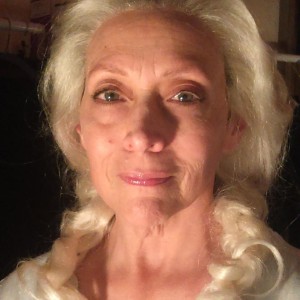Few theatrical assignments are as daunting as Mary Tyrone, the tragic matriarch at the center of Eugene O’Neill’s Long Day’s Journey into Night. The actor playing Mary must expend extraordinary physical and emotional stamina over the course of nearly four hours. She must also contend with the pantheon of powerhouses who’ve tackled the role on stage and screen: Katharine Hepburn, Vanessa Redgrave, Deborah Kerr, Bethel Leslie, Laurie Metcalf and Jessica Lange, to name a few. It’s not an assignment for the faint of heart.
E. Ashley Izard relishes the challenge. The Barrymore Award–winning actor essays the role for Quintessence Theatre Group, in a production running through October 22. I spoke with Ashley during rehearsals about her process of discovery, maintaining her energy over the course of the run, and whether the roiling opioid epidemic influenced her portray of the morphine-addicted Mary. These are edited excerpts of our conversation.
[Quintessence Theatre Group at the Sedgwick Theater, 7137 Germantown Avenue, Philadelphia]; October 4-22, 2017; quintessencetheatre.org.

Cameron Kelsall: How do you approach making the role of Mary Tyrone your own?
E. Ashley Izard: For me, there’s an added sense of daunting responsibility when portraying such an iconic role. Back in 2003, I had the great good fortune of seeing Vanessa Redgrave perform the role on Broadway. And after I learned I would be playing the role, in May of this year, I watched several recorded versions of the play. When I thought about it, my takeaway was how different the interpretations were. Even though they had Mr. O’Neill’s words in common, they were all unique people with their own life experiences to bring to the role. My personal approach, along with bringing my emotional landscape, comes straight from Mr. O’Neill’s words. I would imagine that has probably been the case for other actors, too. It’s all there in the text.
I also had the good fortune to visit the O’Neill House in New London, Conn., in May. It was wonderful to have that experience. Although the “spare room” was locked and unavailable to visitors, I got the sense of what it was like. The room was quite small. I took some photographs of the house, which I’ve been able to share with my cast mates. Alex [Burns, the production’s director and Quintessence’s artistic director] had suggested I go, if I could. He visited also, and his set design is greatly influenced by his seeing it. He told us he actually took the measurements of the room where the entire play is set. I hope to return. It’s beautiful there. It will be an even more memorable visit after having lived this play.
CK: How have you and the rest of the cast built the family dynamic for this play?

EAI: This is such an ensemble piece, and my cast mates really are incredible. We naturally had an easy rapport from the beginning, which was strengthened by Alex devoting the entire first week of rehearsal to table work. That’s really an extraordinary luxury — sitting around and reading the play, then stopping to talk about it. And we all brought our own things to the table, because we all did our own research. We just talked, and through those conversations, we came up with a common understanding of how this family dynamic would function.
CK: What kind of research did you do prior to rehearsal?
EAI: I actually hadn’t known that O’Neill had based the Tyrones on his own family, and specifically that Mary was based on his mother. I don’t think I’d ever really read the play, so a lot of it was new. I picked up one of the latest biographies of O’Neill, and I was fascinated by the story of his real mother. When she had her third baby — Eugene — he was something like eleven pounds, and there was no epidural back then. She was in extraordinary pain, and a doctor gave her morphine. That’s how she got addicted. The book also talks about her going to a convent school and wanting to be a nun, and how she also wanted to be a concert pianist — all of which made its way into the play. It was so interesting to see the level of truth that’s borne out in the text.
CK: I’m sure some people would say there’s an elephant in the room when it comes to this particular play, and that’s the opioid epidemic. Mary Tyrone is clearly an addict. Is that something that’s been on your mind throughout the process — that this story might resonate in new and personal ways for some audience members?
EAI: We haven’t talked about it much in rehearsal, but given the current climate and the tragedy of it all, it’s impossible to do this play without thinking about it. I’ve lost a family member to the epidemic, and there are a couple lines Mary says that always bring him to mind. I think back then, if I remember correctly, morphine was given out pretty casually. But what’s really interesting to me is that although the play is so much about Mary’s addiction, you also have the three men who are alcoholics. So there’s addiction on many levels, even though Mr. O’Neill was commenting primarily on his mother. The alcoholism is much more accepted.
It’s a challenge to try and communicate how Mary feels and acts when she’s doped up. I have no personal experience with that. But O’Neill is so specific about how she speaks and acts — in one stage direction, he writes that “suddenly, abruptly, she changes to a very detached tone.” It’s there. Those stage directions are so critical. They’ve really helped me into the role.
CK: What kind of preparation — physically and emotionally — goes into performing a four-hour play every night that requires this level of emotional engagement?
EAI: My joke answer is Diet Mountain Dew! [Laughs] Really, Mary has a lot to do in the first three hours. That’s why my hat goes off to my male costars, because they have to do the fourth act, which is almost like a play unto itself. That’s especially true of this production, because Alex hasn’t cut a thing. I got to watch a little bit of act four, and I was just so proud of them. Of course, I was watching as Ashley — but I also felt like I was watching as Mary, in a way. It was a very moving experience.
CK: You’ve been working with Quintessence quite a bit lately. What has drawn you back to them across multiple productions?
EAI: Alex Burns has graciously offered me some extraordinary roles over the last four years. Those roles have challenged me and sent me to some extreme emotional places. The experiences have been so rewarding. I love collaborating with Alex — he is brilliant, kind, understanding, and allows me to push my way through to the other side in a role. And the entire Quintessence Theatre Group family is always supportive and top-flight. I enjoy my experiences there immensely, and I’ve been very fortunately to play the roles that I have.
CK: This production runs through October 22. Do you have any other projects in the works?
EAI: I don’t have any other productions lined up. What I am going to do is pick up my camera. Last October, I discovered photography and found that I really loved capturing the beauty and elegance of flowers. I always thought I might enjoy photography, but I never tried it. Now I absolutely love it. I don’t know what else the future will bring, so I’m just going to focus on that.
[Quintessence Theatre Group at the Sedgwick Theater, 7137 Germantown Avenue, Philadelphia]; October 4-22, 2017; quintessencetheatre.org.
